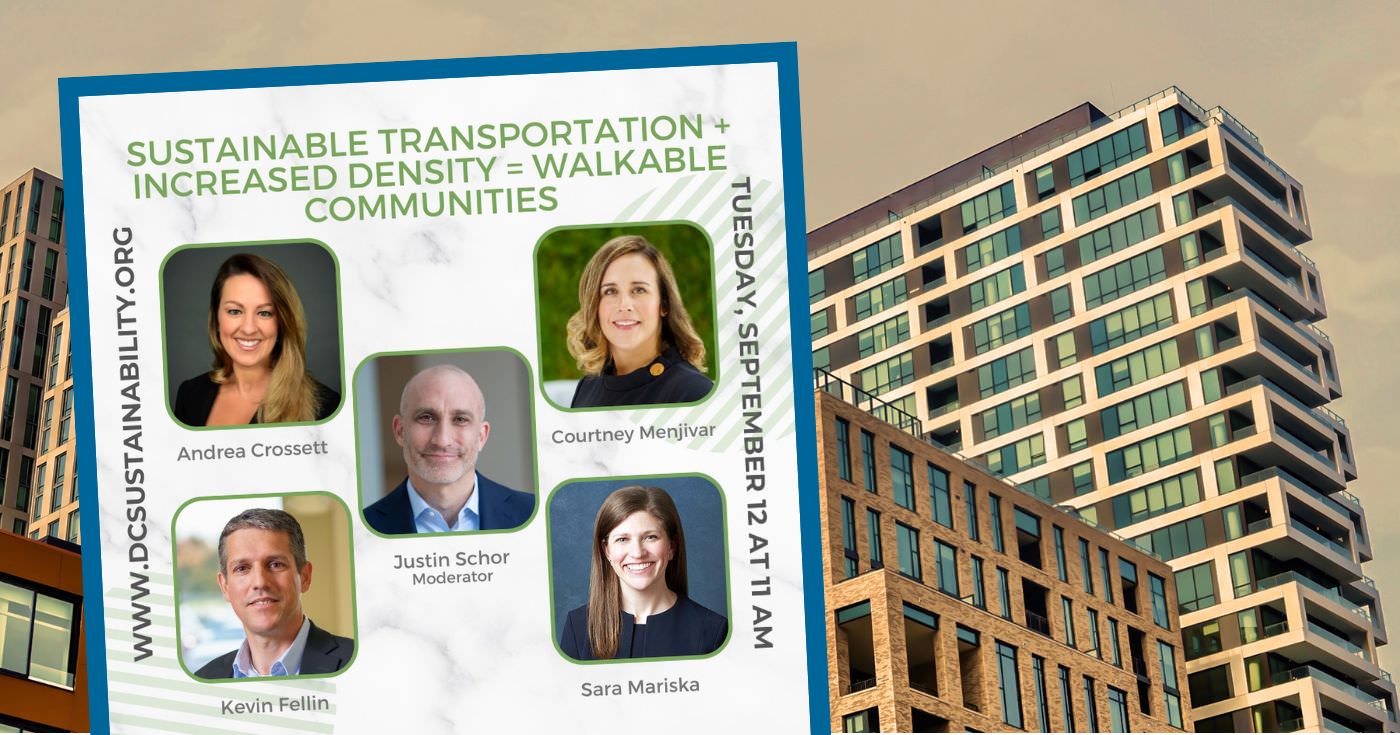Is there an opportunity to harness reductions in peak hour auto traffic to foster the development of more sustainable real estate projects? Our 2022 study in Fairfax County, Virginia concluded that developers across the U.S. can now make a strong case for why traffic congestion concerns should not be an impediment to the approval of higher density developments.
A few of our team members were pleased to join DCS Design’s Sustainability Summit to discuss this evolution of transportation, density, parking, and real estate development.
The session titled “Sustainable Transportation + Increased Density = Walkable Communities” included the following speakers:
- Justin Schor, Courtney Kulyk Menjivar, and Kevin Fellin from Wells + Associates
- Andrea Crossett from LandDesign
- Sara Mariska from Odin Feldman Pittleman
Justin Schor started the panel off as moderator by acknowledging that “the #1 reason that people oppose high density development in their communities is ‘traffic congestion.’”
“The #1 reason that people oppose high density development in their communities is ‘traffic congestion.’” – Justin Schor (Wells + Associates)
The Wells + Associates study in Fairfax County revealed that higher density combined with the management of the demand for single-occupancy vehicles (SOV) leads to more sustainable, walkable communities. The demand for SOVs can be reduced when communities leverage permitting and rezoning processes to require new developments to provide TDM solutions.
The benefits of creating and implementing TDM plans include:
- Increasing revenue via increased density, greater flexibility with land uses, and less stringent setbacks
- Reducing costs via minimized parking construction costs, road capacity enhancements, reduced need for traffic signals, among other methods
A result of these programs has meant that communities can leverage long-term and sustained measurements of reductions in traffic impact to push for more density than is currently allowed.
The panelists explored a range of issues, including:
Traffic Engineering in Higher Density Developments:
Within the discipline of traffic engineering, Wells + Associates has coordinated with Fairfax County staff to restructure how we look at traffic impact studies.
“In Fairfax County, we now call them ‘comprehensive transportation analysis (CTA)’ studies where it’s not just looking at vehicles but at pedestrians and bicycles, getting away from making more turn lanes and how we can better connect residents to transit and their appointment centers.” – Kevin Fellin
TDM, Trip Reductions, and Travel Behavior Change:
Reducing peak hour traffic congestion requires that some individuals we would expect to drive cars shift to either drive them during off-peak hours or use a more sustainable non-auto mode of transportation.
“Changing travel behavior habits to minimize traffic impacts involves a multifaceted approach. You have to consider the characteristics of the building, the users, as well as the surrounding infrastructure. There are a few proven strategies that can be helpful, including transportation demand management, which involves managing, reducing, and redistributing the demand during peak hours.” – Courtney Menjivar (Wells + Associates)
Land Use Policy Allowing for Higher Density Developments:
Although the data show that we should be able to build more density without negatively impacting traffic congestion on the local road network, the local land use policies need to allow for that additional density for it to become a reality. The Site-Specific Plan Amendment (SSPA) Process in Fairfax County creates opportunities for developments to accurately estimate vehicle trips for existing and proposed conditions to propose changes in density or program mix.
“Ultimately, land use policy is a political process. Fairfax County has been very forward thinking and has relied on policy as a way of setting priorities but also being flexible on how they are implemented.” – Sara V. Mariska (Odin Feldman Pittleman) on Land Use Policy
Civil Engineering in Higher-Density Developments:
Traffic congestion is not the only form of infrastructure that can be impacted by higher density. Civil engineers look at other forms of infrastructure like sewage, storm water, tree canopy, and open space.
“As engineers, we understand what it takes to create the functional space and advocate for density that accommodates infrastructure that can sustain growth and development in the long term. We also look for opportunities to build up and not out, to free up some of that space for green infrastructure.” – Andrea Crossett (LandDesign)
You can watch the complete session from the DCS Design Sustainability Conference below.

